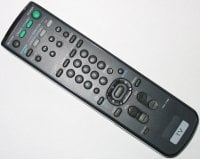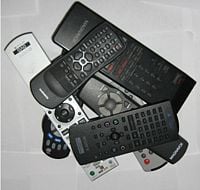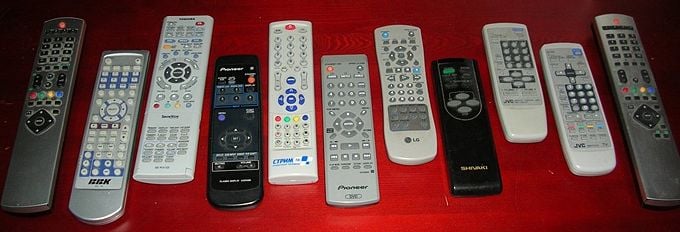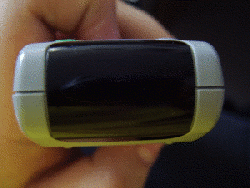Difference between revisions of "Remote control" - New World Encyclopedia
(Reformatted Notes, Refs, checked links, removed bad link, applied Retrieved dates.) |
(→References: Added references.) |
||
| Line 119: | Line 119: | ||
* Gonzalez, Barb. 2005. ''The Home Electronics Survival Guide. The Simple Guide to Understanding, Hooking Up, and Buying TVs, HDTVs, DVDs, Home Theater, Remote Controls and More. Volume 1.'' Cedar Ridge, CA: Home Electronics Survival. ISBN 978-0976489405. | * Gonzalez, Barb. 2005. ''The Home Electronics Survival Guide. The Simple Guide to Understanding, Hooking Up, and Buying TVs, HDTVs, DVDs, Home Theater, Remote Controls and More. Volume 1.'' Cedar Ridge, CA: Home Electronics Survival. ISBN 978-0976489405. | ||
| + | * Sayers, Craig. 1998. ''Remote Control Robotics''. New York, NY: Springer. ISBN 0387985972. | ||
| + | * Lumby, Catharine and Elspeth Probyn. 2004. ''Remote Control: New Media, New Ethics''. Cambridge, UK; New York, NY: Cambridge University Press. ISBN 0521534275. | ||
== External links == | == External links == | ||
Revision as of 17:47, 20 June 2008
- For other uses, see Remote control (disambiguation).
A remote control is an electronic device used for the remote operation of a machine.
The term remote control can be also referred to as "remote" or "controller" when abbreviated. It is known by many other names as well. Commonly, remote controls are used to issue commands from a distance to televisions or other consumer electronics such as stereo systems and DVD players. Remote controls for these devices are usually small wireless handheld objects with an array of buttons for adjusting various settings such as television channel, track number, and volume. In fact, for the majority of modern devices with this kind of control, the remote contains all the function controls while the controlled device itself only has a handful of essential primary controls. Most of these remotes communicate to their respective devices via infrared (IR) signals and a few via radio signals. They are usually powered by small AAA or AA size batteries.
History
One of the earliest examples of remote control was developed in 1893 by Nikola Tesla, and described in his patent,[1] named Method of an Apparatus for Controlling Mechanism of Moving Vehicle or Vehicles.
In 1903, Leonardo Torres Quevedo presented the Telekino at the Paris Academy of Science, accompanied by a brief, and making an experimental demonstration. In the same year, he obtained a patent in France, Spain, Great Britain, and the United States. The Telekino consisted of a robot that executed commands transmitted by electromagnetic waves. It constituted the world's first apparatus for radio control and was a pioneer in the field of remote control. In 1906, in the presence of the king and before a great crowd, Torres successfully demonstrated the invention in the port of Bilbao, guiding a boat from the shore. Later, he would try to apply the Telekino to projectiles and torpedoes, but had to abandon the project for lack of financing.
The first remote-controlled model aeroplane flew in 1932, and the use of remote control technology for military purposes was worked intensively during the Second World War, one result of this being the German Wasserfall missile.
By the late 1930s, several radio manufacturers offered remote controls for some of their higher-end models. Most of these were connected to the set being controlled by wires, but the Philco Mystery Control (1939) was a battery-operated low-frequency radio transmitter [2], thus making it the first wireless remote control for a consumer electronics device.
Television Remote Controls
The first remote intended to control a television was developed by Zenith Radio Corporation in 1950. The remote—officially called "Lazy Bones" was connected to the television set by a wire. To improve the cumbersome setup, a wireless remote control called "Flashmatic" was developed in 1955 which worked by shining a beam of light onto a photoelectric cell. Unfortunately, the cells did not distinguish between light from the remote and light from other sources and the Flashmatic also required that the remote control be pointed very accurately at the receiver.[3]
In 1956 Robert Adler developed "Zenith Space Command," a wireless remote.[4] It was mechanical and used ultrasound to change the channel and volume. When the user pushed a button on the remote control it clicked and struck a bar, hence the term "clicker." Each bar emitted a different frequency and circuits in the television detected this noise. The invention of the transistor made possible cheaper electronic remotes that contained a piezoelectric crystal that was fed by an oscillating electric current at a frequency near or above the upper threshold of human hearing, though still audible to dogs. The receiver contained a microphone attached to a circuit that was tuned to the same frequency. Some problems with this method were that the receiver could be triggered accidentally by naturally occurring noises, and some people, especially young women, could hear the piercing ultrasonic signals. There was even a noted incident in which a toy xylophone changed the channels on these types of TVs since some of the overtones from the xylophone matched the remote's ultrasonic frequency.
The impetus for a more complex type of television remote control came in the late 1970s with the development of the Ceefax teletext service by the BBC. Most commercial remote controls at that time had a limited number of functions, sometimes as few as three: next channel, previous channel, and volume/off. This type of control did not meet the needs of teletext sets where pages were identified with three-digit numbers. A remote control to select teletext pages would need buttons for each number from zero to nine, as well as other control functions, such as switching from text to picture, and the normal television controls of volume, station, brightness, colour intensity and so on. Early teletext sets used wired remote controls to select pages but the continuous use of the remote control required for teletext quickly indicated the need for a wireless device. So BBC engineers began talks with one or two television manufacturers which led to early prototypes in around 1977-78 that could control a much larger number of functions. ITT was one of the companies and later gave its name to the ITT protocol of infrared communication. [5]
Social Effects of the Early Television Remote Control
In the 1950’s remotes were extra upgrades options to T.V. sets. As previously mentioned, Zenith was ready to change the lives of "lazy" people for good.[3] The initial purpose to the T.V. remote was to turn off the T.V. set from afar, and to change the channels or mute commercials. People were told that the remote could turn off the T.V. while they were still laying in their LaZBoy and thus could drift off to sleep without interruption. A common complaint was that people tripped on the cable that was attached to the first remotes. It was not until 1955 that Zenith created the “Flash-matic” or their first wireless remote. While it helped keep the flow of traffic without tipping people along the way, the “Flash-matic” was not flawless. It frustrated people when the sun would hit the T.V. set, thus changing the channel.
The remote gave viewers an opportunity to “arm” themselves. Viewers no longer watched a show because they did not want to get up to turn the channel. [6]
Audiences were “armed” with the ability to change their minds about what they were watching. It allowed audiences, for the first time, to interact with their T.V.. The remote’s technology and buzz started something the first of its kind for the everyday T.V. viewer: the Joystick.[7] The Joystick allowed people to interact with their T.V., liberating the kinds of interaction they had with their television. Pong- the game in which people first used joysticks- was a basic game that was based on ping-pong. This new technology gave the average T.V. owner the ability to manipulate his or her own pixel on the T.V. screen for the first time.[8]
The invention of the remote control has led to several different changes in television programming. One thing that the remote control led to was the creation of split screen credits. According to James Gleick, an NBC research team discovered that when the credits started rolling after a program, 25% of its viewers would change the channel before it was over. Because of this, the NBC 2000 unit invented the “squeeze and tease” which squeezed the credits onto one third of the screen while the final minutes of the broadcast aired simultaneously.[9]
The remote control also led to an adjustment in commercial airings. Networks began to feel that they could not afford to have commercials between programs because it would detract viewers from staying tuned in on their channel. Programmers decided to place commercials in the middle of programs in order to transition into the next show directly.[10]
With networks keeping in mind that people were equipped with remotes, thirty-second advertisement spots were cut down into segments of eight seconds or less. MTV was made up of this high-speed and broken cutting style, which aired music videos that were around three-minutes and each shot no more than two or three seconds. But MTV felt that even these three-minute segments were too long, so they created an animated series called Beavis and Butthead, to keep their viewer’s attention. [11] In the show, they would show segments of music videos and then switch back to the characters and offer dialogue and action while the music video played in the background. Beavis and Butthead was purposefully stagnant, with slow dialogue and depending on reaction shots, but animation takes the most management and the pacing is everything. The last fraction of a second of sound track overlaid with the first fraction of a second of the visual track for the next scene.[12]
Other Remote Controls
In the 1980s Steve Wozniak of Apple, started a company named CL 9. The purpose of this company was to create a remote control which could operate multiple electronic devices. The CORE unit as it was named (Controller Of Remote Equipment) was introduced in the fall of 1987. The advantage to this remote controller was that it could “learn” remote signals from other different devices. It also had the ability to perform specific or multiple functions at various times with its built in clock. It was also the first remote control which could be linked to a computer and loaded with updated software code as needed. The CORE unit never made a huge impact of the market. It was much too cumbersome for the average user to program, but it received rave reviews from those who could figure out how to program it. These obstacles eventually lead to the demise of CL 9, but one of its employees continued the business under the name Celadon. This was one of the first computer controlled learning remote controls on the market. [13]
By the early 2000s, the number of consumer electronic devices in most homes greatly increased. According to the Consumer Electronics Association, an average American home has four remotes. To operate a home theater as many as five or six remotes may be required, including one for cable or satellite receiver, VCR or digital video recorder, DVD player, TV and audio amplifier. Several of these remotes may need to be used sequentially, but, as there are no accepted interface guidelines, the process is increasingly cumbersome. Many specialists, including Jakob Nielsen [14], a renowned usability specialist and Robert Adler, the inventor of the modern remote, note how confusing, unwieldy and frustrating the multiplying remotes have become.
Technique
Most control remotes for electronic appliances use a near infrared diode to emit a beam of light that reaches the device. A 940 nm wavelength LED is typical. This infrared light is invisible to the human eye but carries signals that are detected by the appliance, as well as by the sensor of a digital camera.
With a single channel (single-function, one-button) remote control the presence of a carrier signal can be used to trigger a function. For multi-channel (normal multi-function) remote controls more sophisticated procedures are necessary: one consists of modulating the carrier with signals of different frequency. After the demodulation of the received signal, the appropriate frequency filters are applied to separate the respective signals. Nowadays digital procedures are more commonly used. One can often hear the signals being modulated on the infrared carrier by operating a remote control in very close proximity to an AM radio not tuned to a station.
Some remotes use radio frequency signals.
Usage
Industry
Remote control is used for controlling substations, pump storage power stations and HVDC-plants. For these systems often PLC-systems working in the longwave range are used.
Emergency
Remotely controlled machinery is used in radioactive or toxic environments to avoid human casualties and to prevent damage to human health. For example, remotely controlled robots were used during liquidation of circumstances of Chernobyl disaster.
Military
In World War I the Imperial German Navy employed FL-boats (Fernlenkbootes) against coastal shipping. These were driven by internal combustion engines, and controlled remotely from a shore station through several miles of wire wound on a spool on the boat. An aircraft was used to signal directions to the shore station. EMBs carried a high explosive charge in the bow and traveled at speeds of thirty knots.[15]
The Soviet Red Army used remotely controlled teletanks during 1930s in the Winter War against Finland and the early stages of the Great Patriotic War. A teletank is controlled by radio from a control tank at a distance of 500–1,500 meters, the two constituting a telemechanical group. The Red Army fielded at least two teletank battalions at the beginning of the Great Patriotic War. There were also remotely controlled cutters and experimental remotely controlled planes in the Red Army.
Space
Remote control technology is also used in space travel, for instance the Russian Lunokhod vehicles were remote-controlled from the ground. Direct remote control of space vehicles at greater distances from the earth is not practical due to increasing signal delay times.
Video games
Video game consoles had not used wireless controllers until recently, mainly because of the difficulty involved in playing the game while keeping the infrared transmitter pointed at the console. Early wireless controllers were cumbersome and when powered on alkaline batteries, lasted only a few hours before they needed replacement. Some wireless controllers were produced by third parties, in most cases using a radio link instead of infrared. Even these were very inconsistent, and in some cases, had transmission delays, making them virtually useless. The first official wireless controller made by a first party manufacturer was the WaveBird for Nintendo Gamecube. The Wavebird changed the face of wireless technology in video game consoles. In the current generation of gaming consoles, wireless controllers have become the standard.
Toys
Template:Cleanup-section
Remote control toys, such as racing cars, boats and even aircraft are a favorite pastime of many people.
Planes
Remote controlled planes serves as a great hobby for all ages, it has the same fuselage as a real plane and it flies just as well. If the wing of the remote controlled plane is in a airfoil form and it creates a high and low pressure and creates lift, the plane would fly. This is helped by a small electric motor that creates thrust and the plane flies. you get different types of channels that controls the plane. 2 Channel is mostly for beginners and you control the plane through its rudder and elevators. 3 channel is also for beginners and experienced pilots because you have control over the motor speed as well, the motor will set your pitch. Higher speed: faster climbing, lower speed: fast descents. 4 channel radio's is normally for all of above including ailerons which lets you turn smoother, were as your rudder turns makes the turn slower and it slows the plane's airspeed. 5-8 channel radios is things like gear up and down etc. but its things that you don't need.
The rudder, ailerons, elevators etc. is controlled by servos which is connected to the receiver, the receiver gives the commands that the transmitter (radio) sends it, you have control over the transmitter.
Types
You get different types of remote controlled planes, but they all operate in the same way. You get biplanes, fixed wing, jets, turbined jets etc. The turbine planes is powered by a small turbine that works the same way as a real turbine but its much smaller. This "mini-turbines" is very powerful. the more common RC planes are the ones with a electric or nitro powered planes.
You get RC planes of all sizes. The smallest has a wingspan of 8 cm and the biggest one is over 5 metres long.
Although remote controlled planes are very fun, there is a trick in how to fly it and people who want to begin this hobby has to read the forums on which plane to buy and how to fly it.
Standby power
To be turned on by a wireless remote, the controlled appliance must always be partly on, consuming standby power. Studies indicate that around 5-10% of domestic electricity is consumed by appliances when they are off. In the average home, 75% of the electricity used to power home electronics is consumed while the products are turned off.[16]
See also
- Universal remote
- Channel surfing
- Radio control
- Domotics
- Audience response
- Remote keyless system
- Telecommand
- Remote-controlled animal
- Control Car Remote Control Locomotive
- Garage door opener
Notes
- ↑ U.S. Patent 613809 (PDF). Retrieved June 20, 2008.
- ↑ Philco Mystery Control. Philco Repair Bench. Retrieved June 20, 2008.
- ↑ 3.0 3.1 Five Decades of Channel Surfing: History of the TV Remote Control. Zenith. Retrieved June 20, 2008.
- ↑ Farhi, Paul. 2007. The Inventor Who Deserves a Sitting Ovation. Washington Post. Retrieved June 20, 2008.
- ↑ SB-Projects: IR remote control: ITT protocol. sbprojects.com. Retrieved June 20, 2008.
- ↑ Bellis, Mary. The History of the Television Remote Control. About.com. Retrieved June 20, 2008.
- ↑ Rushkoff, Douglas. 2005. "Renaissance Now! Media Ecology and the New Global Narrative." in E. Page Bucy. 2005. Living in the Information Age. Belmont, CA: Wadsworth Thomson Learning. ISBN 9780534633400. page 25.
- ↑ Kent, Steven L. 2001. The Ultimate History of Video Games. Roseville, CA: Prima Pub. ISBN 9780761536437. page 27.
- ↑ Gleick, James. 2005. "Prest-O! Change-O!". in E. Page Bucy. 2005. Living in the Information Age. Belmont, CA: Wadsworth Thomson Learning. ISBN 9780534633400. page 147.
- ↑ Gleick. 2005. page 148.
- ↑ Gleick. 2005. page 149.
- ↑ Gleick. 2005. page 150.
- ↑ Celadon Remote Control Systems Company Profile Page. Celadon. Retrieved June 20, 2008.
- ↑ Nielsen, Jakob. 2004. Jakob Nielsen's Alertbox: Remote Control Anarchy. Alertbox. Retrieved June 20, 2008.
- ↑ Lightoller, C.H. 1935. Titanic and other ships. London, UK: I. Nicholson and Watson.
- ↑ Home Office and Home Electronics. EERE. Retrieved June 20, 2008.
ReferencesISBN links support NWE through referral fees
- Gonzalez, Barb. 2005. The Home Electronics Survival Guide. The Simple Guide to Understanding, Hooking Up, and Buying TVs, HDTVs, DVDs, Home Theater, Remote Controls and More. Volume 1. Cedar Ridge, CA: Home Electronics Survival. ISBN 978-0976489405.
- Sayers, Craig. 1998. Remote Control Robotics. New York, NY: Springer. ISBN 0387985972.
- Lumby, Catharine and Elspeth Probyn. 2004. Remote Control: New Media, New Ethics. Cambridge, UK; New York, NY: Cambridge University Press. ISBN 0521534275.
External links
- Description of infrared remote protocols. Retrieved June 20, 2008.
- Infra-red Remote Control Theory. Retrieved June 20, 2008.
- Five Decades of Channel Surfing: History of the TV Remote Control. Retrieved June 20, 2008.
- New Remote's History of the Remote Control. Retrieved June 20, 2008.
Credits
New World Encyclopedia writers and editors rewrote and completed the Wikipedia article in accordance with New World Encyclopedia standards. This article abides by terms of the Creative Commons CC-by-sa 3.0 License (CC-by-sa), which may be used and disseminated with proper attribution. Credit is due under the terms of this license that can reference both the New World Encyclopedia contributors and the selfless volunteer contributors of the Wikimedia Foundation. To cite this article click here for a list of acceptable citing formats.The history of earlier contributions by wikipedians is accessible to researchers here:
The history of this article since it was imported to New World Encyclopedia:
Note: Some restrictions may apply to use of individual images which are separately licensed.





